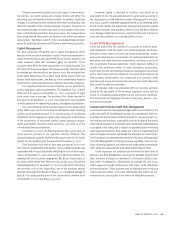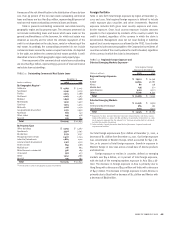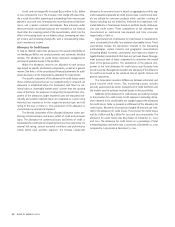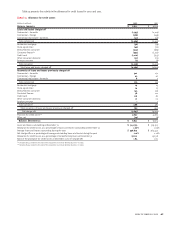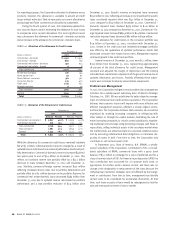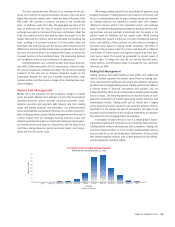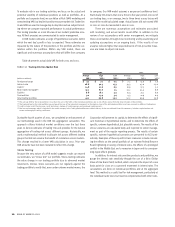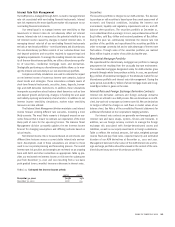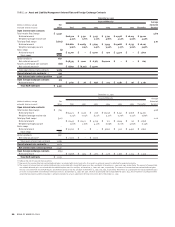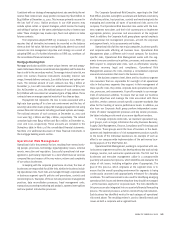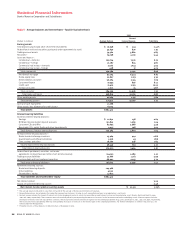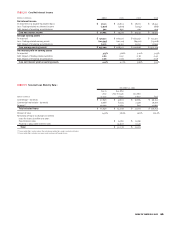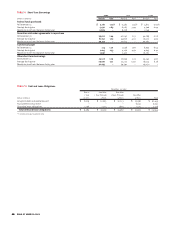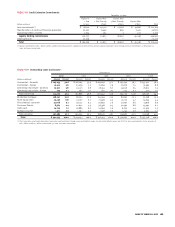Bank of America 2002 Annual Report Download - page 53
Download and view the complete annual report
Please find page 53 of the 2002 Bank of America annual report below. You can navigate through the pages in the report by either clicking on the pages listed below, or by using the keyword search tool below to find specific information within the annual report.
Interest Rate Risk Management
Our ALM process, managed through ALCO, is used to manage interest
rate risk associated with non-trading financial instruments. Interest
rate risk represents the most significant market risk exposure to our
non-trading financial instruments.
Our overall goal is to manage interest rate sensitivity so that
movements in interest rates do not adversely affect net interest
income. Interest rate risk is measured as the potential volatility to our
net interest income caused by changes in market interest rates. In
managing interest rate risk of our non-trading financial instruments
we look at two broad portfolios – non-discretionary and discretionary.
The non-discretionary portfolio consists of our customer-driven loan
and deposit positions and securities required to support legal and
regulatory requirements. To manage the resulting interest rate sensitiv-
ity of the non-discretionary portfolio, we utilize a discretionary portfo-
lio of securities, residential mortgage loans and derivatives.
Strategically positioning our discretionary portfolio allows us to man-
age the interest rate sensitivity in our non-discretionary portfolio.
Complex sensitivity simulations are used to estimate the impact
on net interest income of numerous interest rate scenarios, balance
sheet trends and strategies. These simulations estimate levels of
short-term financial instruments, securities, loans, deposits, borrow-
ings and ALM derivative instruments. In addition, these simulations
incorporate assumptions about balance sheet dynamics such as loan
and deposit growth and pricing, changes in funding mix and asset
and liability repricing and maturity characteristics. In addition to net
interest income sensitivity simulations, market value sensitivity
measures are also utilized.
The Balance Sheet Management division maintains a net interest
income forecast utilizing different rate scenarios, including a most
likely scenario. The most likely scenario is designed around an eco-
nomic forecast that is meant to estimate our expectation of the most
likely path of rates for the upcoming horizon. The Balance Sheet
Management division constantly updates the net interest income
forecast for changing assumptions and differing outlooks based on
actual results.
Net interest income risk is measured based on rate shocks over
different time horizons versus a current stable interest rate environ-
ment. Assumptions used in these calculations are similar to those
used in our corporate planning and forecasting process. The overall
interest rate risk position and strategies are reviewed on an ongoing
basis with ALCO and other committees as appropriate. Table 19 pro-
vides our estimated net interest income at risk over the subsequent
year from December 31, 2002 and 2001 resulting from a 100 basis
point gradual (over 12 months) increase or decrease in interest rates.
TABLE 19 Estimated Net Interest Income at Risk
-100 bp +100 bp
December 31, 2002 (2.4)% 1.5%
December 31, 2001 (0.8) 0.4
Securities
The securities portfolio is integral to our ALM activities. The decision
to purchase or sell securities is based upon the current assessment of
economic and financial conditions, including the interest rate
environment, liquidity and regulatory requirements and on- and off-
balance sheet positions. The securities portfolio at December 31,
2002 ended down from a year ago. In 2002, we purchased securities of
$146 billion, sold $137 billion and received paydowns of $25 billion.
During the year, we continuously monitored the interest rate risk
position of the portfolio and repositioned the securities portfolio in
order to manage convexity risk and to take advantage of interest rate
fluctuations. Through sales of the securities portfolio, we realized
$630 million in gains on sales of securities during the year.
Residential Mortgage Portfolio
We repositioned the discretionary mortgage loan portfolio to manage
prepayment risk resulting from the unusually low rate environment.
The residential mortgages designated solely for ALM activities grew
primarily through whole loan purchase activity. In 2002, we purchased
$55.0 billion of residential mortgages in the wholesale market for our
discretionary portfolio and interest rate risk management. During the
same period, we sold $22.7 billion of whole mortgage loans and recog-
nized $500 million in gains on the sales.
Interest Rate and Foreign Exchange Derivative Contracts
Interest rate derivative contracts and foreign exchange derivative
contracts are utilized in our ALM process. We use derivatives as an effi-
cient, low-cost tool to manage our interest rate risk. We use derivatives
to hedge or offset the changes in cash flows or market values of our
balance sheet. See Note 5 of the consolidated financial statements for
additional information on the Corporation’s hedging activities.
Our interest rate contracts are generally non-leveraged generic
interest rate and basis swaps, options, futures and forwards. In
addition, we use foreign currency contracts to manage the foreign
exchange risk associated with foreign-denominated assets and
liabilities, as well as our equity investments in foreign subsidiaries.
Table 20 reflects the notional amounts, fair value, weighted average
receive fixed and pay fixed rates, expected maturity and estimated
duration of our ALM derivatives at December 31, 2002 and 2001.
Management believes the fair value of the ALM interest rate and for-
eign exchange portfolios should be viewed in the context of the com-
bined discretionary and non-discretionary portfolios.
BANK OF AMERICA 2002 51


